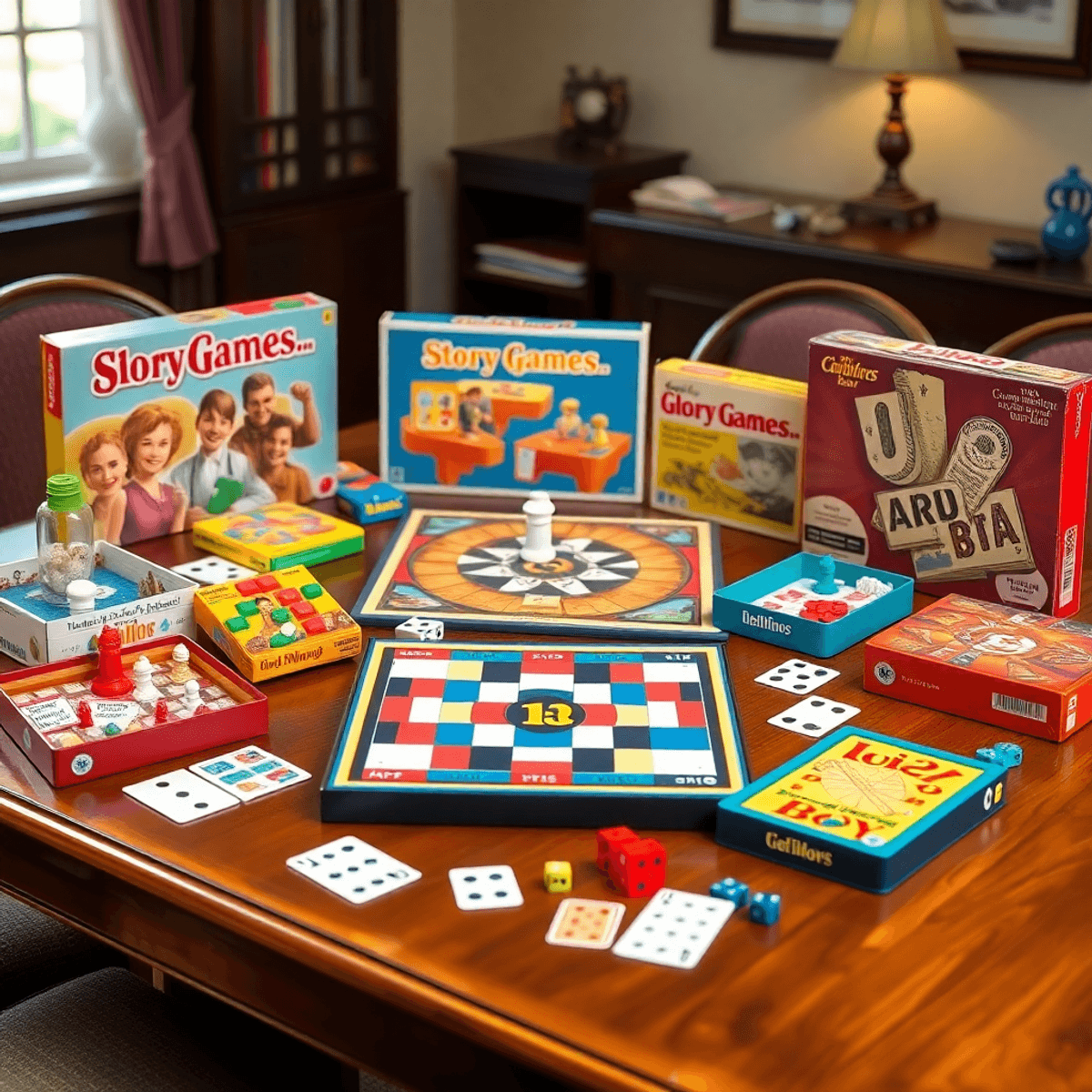
The 1950s was a significant time in board game history, with both impressive growth and eventual decline. After World War II, board games became extremely popular in America, captivating families all over the country. During this time, legendary games were created that would shape the industry for years to come.
What makes this period particularly interesting is the combination of social and economic factors at play. The rise of suburban living, more disposable income, and a focus on family entertainment all contributed to an unprecedented demand for tabletop gaming experiences. Sales went through the roof as manufacturers rushed to create new and exciting games.
However, by the end of the decade, this golden age faced unexpected challenges. The same things that had caused the board game boom – excitement in the market and consumer demand – ended up leading to its decline. The growing influence of television, saturation in the market, and changing preferences in entertainment reshaped how Americans spent their free time.
In this exploration, we will look into:
- The iconic games that defined the era
- Market forces driving the industry’s expansion
- Cultural factors influencing gaming trends
- The eventual decline and its lasting impact on gaming history
The Golden Age of Board Games in the 1950s
After World War II, the economy was doing well, which created the perfect conditions for the board game industry to thrive. American families, settling into suburban lifestyles, sought affordable entertainment options that could bring everyone together around the table. This time period, often called the golden age of board games, saw a significant boom in the industry from the 1950s to the 1970s. It led to the creation of popular games and new ideas that shaped modern gaming.
Key Titles that Defined the Era
Several board games became iconic during this period:
Monopoly emerged as the quintessential American board game, teaching players about property ownership and financial management. According to Hasbro records, Monopoly sales peaked in 1954, with over 4 million copies sold that year alone.

Risk, introduced by Parker Brothers in 1959, changed the way people played strategic games. Its complex military conquest mechanics and diplomatic elements appealed particularly to older children and adults, establishing a new genre of strategy board games.
Clue (1949) carried its momentum into the 1950s, captivating players with its murder mystery premise. The Strong National Museum of Play notes that Clue’s success sparked a trend of detective-themed games throughout the decade.
Scrabble experienced unprecedented growth during this period. From modest beginnings, it became a cultural phenomenon when Macy’s chairman Jack Straus discovered the game on vacation. By 1954, Scrabble was selling 4 million sets annually.
Demographics and Appeal
Different games targeted specific market segments:
- Family Games
- Candy Land (1949) – Designed for young children
- The Game of Life – Appealed to families with its life simulation theme
- Sorry! – Simple mechanics made it accessible to all ages
- Adult-Oriented Games
- Scrabble – Attracted word enthusiasts and educated professionals
- Risk – Drew strategic thinkers and history buffs
- Bridge – Maintained popularity among social groups
The success of these games came from their ability to:
- Provide educational value while entertaining
- Create social interaction opportunities
- Offer replayability through varied gameplay experiences
- Reflect contemporary American values and aspirations
Innovation and Market Dynamics
The economic prosperity after World War II led to an unprecedented wave of innovation in board game design. Game manufacturers began incorporating mechanical elements and three-dimensional components into their games, completely transforming the traditional flat-board gameplay experience.
Notable Innovations in Board Games
Some notable examples of this innovative approach include:
- Parker Brothers’ “Voice of the Mummy” (1971), which featured a talking mechanical sphinx
- “Mouse Trap” (1963), which showcased intricate Rube Goldberg-style contraptions
These games demonstrated how technology could be used to enhance gameplay and create more immersive experiences for players.
Consumer Spending on Board Games
Market research from that time period reveals some interesting insights into consumer behavior:
- On average, American families spent $15-20 per year on board games
- The holiday season accounted for a significant portion (60%) of annual sales
- Department stores had dedicated sections for board games
- Prices of games ranged from $2-5, making them affordable for middle-class households
This data indicates that board games were popular forms of entertainment among families during this era, with specific buying patterns around holidays and accessibility through department stores.
Suburban Growth and Its Impact on the Board Game Industry
The growth of the board game industry was closely tied to the expansion of suburban areas. According to census data, suburban populations increased by 43% between 1950 and 1960, creating favorable conditions for at-home entertainment options like board games.
In response to this trend, game manufacturers took several strategic actions:
- They established regional distribution networks to reach customers in different areas
- They implemented mass production techniques to produce games at a larger scale
- They developed targeted advertising campaigns to promote their products
- They created specialized games tailored for specific age groups
These efforts allowed manufacturers to cater to the growing demand for board games in suburban households.
Increasing Competition in the Board Game Industry
The rapid growth of the industry also attracted new players into the market. Between 1945 and 1955, the number of game companies doubled, leading to increased competition among manufacturers.
While this competitive environment encouraged innovation as companies sought ways to differentiate themselves from one another, it also posed challenges such as potential market saturation if too many similar products flooded the market.
Overall, these factors – innovation driven by technological advancements, consumer spending patterns influenced by holidays and affordability, suburban growth creating opportunities for at-home entertainment, and increasing competition within the industry – all played significant roles in shaping the dynamics of the board game market during this period.
Factors Contributing to the Decline of Board Games in the Late 1950s
The vibrant board game market of the early 1950s faced significant challenges as the decade progressed. A surge in game manufacturers flooded the market with similar products, creating an oversaturated landscape where distinctive brands struggled to maintain their identity. Market research from the period indicates that by 1957, over 200 new board game titles were being released annually, compared to just 50 per year in 1950.
The Impact of Television on Board Game Sales
The rise of television proved particularly devastating to board game sales. By 1955, approximately 67% of American households owned a television set, dramatically altering family entertainment patterns. Evening hours once dedicated to board games shifted to watching popular TV shows, with Nielsen ratings showing average viewing times increasing from 3 hours to 5 hours per day between 1950 and 1959.
Key Factors in Market Decline:
- Brand dilution from copycat games flooding store shelves
- Reduced consumer interest due to market saturation
- Declining product innovation and originality
- Competition from emerging entertainment alternatives
The Influence of Television Advertising
Television’s impact extended beyond mere entertainment competition. TV advertising created new consumer desires and expectations for interactive entertainment. Traditional board games, with their static nature, began to seem outdated compared to the dynamic visual medium of television.
The Rise of Electronic Games
The entertainment landscape underwent further transformation as early electronic games emerged. While full-scale video games wouldn’t arrive until later decades, primitive electronic entertainment devices began appearing in the late 1950s. The Nimrod computer, created in 1951, demonstrated the potential for electronic gaming, sparking public interest in new forms of interactive entertainment.
Consumer Behavior Shifts:
- Increased preference for passive entertainment
- Growing desire for instant gratification
- Reduced family gathering times
- Rising interest in technological novelty
These market pressures forced many smaller game manufacturers out of business, while larger companies struggled to maintain profitability. Parker Brothers reported a 30% decline in board game sales between 1956 and 1959.
However, despite this decline, board games have seen a resurgence in recent years. There are now best family board games available for all ages that can bring families together again. For those interested in starting their own collection of these timeless games, there are essential tips on how to start a board game collection. Additionally, if you’re looking for social experiences around gaming, you can find local board game meetups through resources that guide you on where to find events near you.
Conclusion: Lessons Learned from the Rise and Fall Narrative of 1950s Board Games for Modern Industries
The 1950s board game phenomenon offers valuable insights for today’s entertainment industries. The rapid success and subsequent decline of board games during this era highlights essential business principles that remain relevant:
- Market Timing Matters: The post-war economic boom created perfect conditions for board game success, demonstrating how timing can amplify product potential.
- Innovation is Key: Companies that maintained success, like Hasbro, did so through continuous product development and adaptation.
- Diversification Prevents Decline: Relying solely on existing products leads to market saturation, as seen in the late 1950s board game industry.
- Consumer Behavior Shifts Rapidly: The swift transition from board games to television entertainment shows how quickly market preferences can change.
These lessons resonate particularly with modern digital entertainment companies. The board game industry’s 1950s journey mirrors current challenges in maintaining relevance amid evolving technology and consumer preferences. Success requires balancing tradition with innovation while staying attuned to changing social dynamics.
Research shows that industries that adapt to cultural shifts while preserving core entertainment values tend to maintain long-term sustainability, a principle demonstrated by surviving board game companies that embraced change without losing their fundamental appeal.
Conclusion: Lessons Learned from the Rise and Fall Narrative of 1950s Board Games for Modern Industries
The legacy of 1950s board games offers valuable insights for today’s entertainment industries. The rapid rise and subsequent decline of board games during this era demonstrates the critical importance of:
- Innovation Sustainability – Success requires continuous product evolution beyond initial market excitement
- Market Saturation Awareness – Flooding markets with similar products can diminish brand value and consumer interest
- Adaptation to Technology – Industries must evolve alongside emerging entertainment formats rather than compete against them
- Consumer Behavior Analysis – Understanding shifting entertainment preferences helps maintain market relevance
The board game industry’s 1950s trajectory mirrors modern digital entertainment trends. Companies like Nintendo and Hasbro have successfully navigated market changes by:
- Embracing technological integration
- Maintaining core brand identity
- Creating cross-platform experiences
- Developing unique value propositions
These strategies reflect lessons learned from the 1950s board game boom and bust, where companies that failed to adapt faced significant market challenges. The era’s experience highlights how entertainment industries must balance innovation with market sustainability while maintaining authentic connections with their audience.



